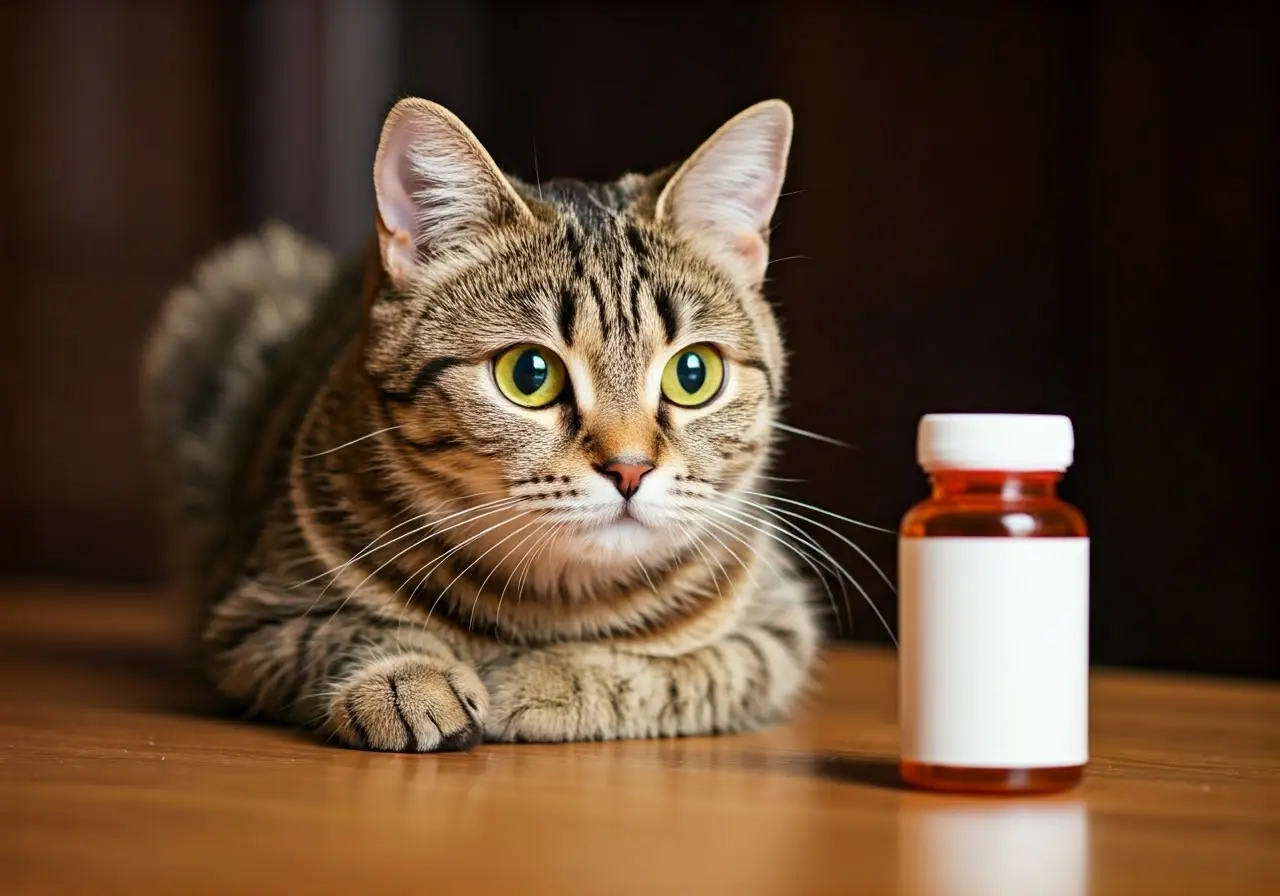Cats, like all pets, can sometimes get sick or develop chronic conditions that require medication. Recognizing the signs early can be crucial for their health and well-being. This blog will help you identify those signs and provide you with tips on how to administer the medication effectively.
1. Changes in Appetite
If your cat suddenly loses interest in food or starts eating much more than usual, it could be a sign of an underlying health issue that requires medication. Changes in appetite can indicate various conditions, such as gastrointestinal disorders or thyroid problems. A decrease in appetite can be particularly concerning if it goes on for more than a day or two. Cats refusing food potentially indicates pain or other severe conditions, like kidney disease or infections. Always monitor your kitty’s eating habits closely and consult your vet for guidance.
2. Lethargy and Fatigue
Cats are known for their energy bursts followed by long naps. However, if your cat is overly lethargic or constantly tired, it may be a sign that they need medical attention. Lethargy can be symptomatic of an array of health issues, including viral infections, anemia, or chronic diseases. A cat that sleeps significantly more than usual or lacks interest in playtime might be trying to tell you something’s not right. Identifying these early signs could be pivotal in obtaining timely treatment.
Additionally, a sudden increase in sleep or inactivity might be due to conditions such as hypothyroidism, arthritis, or even depression in cats. Cats naturally hide pain and illness, making it essential to note any deviations in their typical behavior. Regular veterinary check-ups can help in identifying the underlying causes of such changes, ensuring your feline friend receives the necessary medication and care.
3. Weight Loss or Gain
Unexplained changes in weight can be a symptom of various health conditions. Weight loss or gain should prompt a visit to the vet. Sudden weight loss could signify diabetes, hyperthyroidism, or cancer, whereas weight gain might point to issues like hypothyroidism or fluid retention due to heart disease. Monitoring your cat’s weight regularly can help you catch these issues early.
A consistent routine of weighing your cat can make a critical difference in spotting these fluctuations early. You may find that certain dietary changes or prescribed medication can address metabolic issues or other conditions responsible for the weight variations. Act promptly by scheduling a vet visit if you notice rapid changes, ensuring your cat gets the right treatment plan tailored to its needs.
4. Behavioral Changes
Noticeable changes in your cat’s behavior, such as aggression, hiding, or increased vocalization, can indicate that they may be in pain or discomfort. Cats may exhibit aggression due to nausea or irritability brought on by an illness. Increased vocalization might mean they are experiencing pain, disorientation, or discomfort. Recognizing behavioral changes early can lead to timely intervention and treatment.
Stress and anxiety can also manifest as behavioral changes in cats. Sometimes, these changes are subtle, such as avoiding favorite spots or suddenly becoming clingy. Keeping a close eye on your pet’s daily habits can provide clues. Discussing these observations with your vet will aid in diagnosing conditions that might require medication, thus improving your cat’s overall well-being.
5. Frequent Vomiting
While occasional vomiting might not be a concern, frequent vomiting is a sign that something could be seriously wrong. Chronic vomiting can be a result of gastrointestinal issues, food allergies, or even poisoning. Knowing when to seek veterinary care can be crucial for your cat’s health. Vomiting paired with lethargy or appetite loss should be evaluated by a vet to rule out severe conditions like kidney failure or cancer. Immediate medical attention can often prevent more serious complications.
If the vomiting is accompanied by other symptoms such as diarrhea, dehydration might set in quickly, making the situation even more urgent. Your vet might recommend dietary adjustments or prescribe medication to manage the condition. Keeping a log of your cat’s vomiting episodes, including any triggers or patterns, can help your vet diagnose the issue more efficiently.
6. Diarrhea or Constipation
Changes in your cat’s bowel movements, such as diarrhea or constipation, can be an indication of health problems. Diarrhea might result from infections, parasites, or dietary issues, while constipation could signal a blockage, dehydration, or underlying chronic conditions. Ensuring your cat receives a balanced diet and staying vigilant about its litter box habits are essential for early detection. Persistent digestive issues often require veterinary attention to prevent further complications.
Both diarrhea and constipation can lead to discomfort and longer-term health risks if left untreated. Over-the-counter remedies should never be attempted without veterinary advice. A vet visit will often include diagnostic tests to determine the root cause, followed by a treatment plan that may include medication, dietary changes, or other interventions to restore your cat’s digestive health.
7. Changes in Grooming Habits
Cats are meticulous groomers. If you notice your cat over-grooming or not grooming at all, it may need medical evaluation. Over-grooming could indicate skin issues, allergies, or stress, while a lack of grooming might signal arthritis, obesity, or underlying illnesses. Unkept coats or bald patches are often clues that something isn’t right. Discuss these changes with your vet to get to the bottom of the issue.
In addition to physical health concerns, grooming changes may also point to emotional stressors in your cat’s environment. Ensuring a comfortable, stress-free environment and seeking advice from your vet can help determine whether the changes are physical, psychological, or a mix of both. A thorough check-up will help address health problems and develop a care plan that supports your cat’s grooming habits.
8. Breathing Issues
Difficulty breathing, wheezing, or coughing can be signs of respiratory problems needing medical attention. Respiratory distress might stem from conditions like asthma, heart disease, or infections. Labored breathing and wheezing are red flags that require immediate veterinary evaluation. Your vet can conduct diagnostic tests, such as X-rays or blood work, to determine the cause and prescribe appropriate treatment.
Routine monitoring of your cat’s breathing patterns can help in identifying issues early. Using humidifiers or eliminating allergens from the home might help manage mild cases, but only under veterinary guidance. Severe or sudden breathing problems always warrant urgent care to ensure your cat’s safety and well-being.
9. Frequent Urination or Difficulty Urinating
Issues related to urination, like increased frequency or difficulty, can indicate urinary tract infections or other problems. UTIs, bladder stones, or kidney disease can severely affect your cat’s health if not treated promptly. Difficulty urinating or blood in the urine are especially concerning and require immediate veterinary attention. Frequent urination and pain while urinating can also signify more serious conditions like blockages, which can be fatal if untreated.
Keeping an eye on your cat’s litter box habits can provide valuable insights into their urinary health. Veterinary care often includes urinalysis, blood tests, and sometimes imaging to diagnose the issue accurately. Treatments may range from dietary changes to antibiotics or even surgery in severe cases. Early detection and intervention can significantly improve your cat’s quality of life.
10. Limping or Difficulty Moving
If your cat is limping or has difficulty moving, it could be due to pain or arthritis, which might require medication. Joint pain is common in older cats, and early intervention can help manage it effectively. Mobility issues and discomfort can also result from injuries or neurological problems. Your vet can recommend treatments like pain relief medication, joint supplements, or lifestyle changes to make your cat more comfortable.
Implementing simple changes at home, like providing soft bedding or ramps, can also assist your cat in moving comfortably. Consistent veterinary check-ups will help track your cat’s progress and make necessary adjustments to the treatment plan. These proactive steps can greatly enhance your pet’s mobility and overall happiness.
11. Physical Changes
Lumps, bumps, or other physical abnormalities should always be checked by a vet. While some may be benign, others could signify serious conditions like cancer. Regular grooming and petting sessions allow you to feel for any unusual growths or changes in your cat’s skin or fur. Early detection through routine vet visits is crucial for treating potentially life-threatening conditions.
Don’t ignore changes in skin texture, color, or sores that don’t heal. These signs can point to a variety of health issues that need immediate attention. Your vet might perform biopsies or other diagnostic tests to identify the nature of the abnormality. Timely treatment can significantly improve your cat’s prognosis and quality of life.
12. Excessive Thirst
An increase in thirst can be a sign of diabetes or kidney disease. Cats are generally not heavy drinkers, so noticing them visiting the water bowl more often is a red flag. Monitoring their water intake can help you detect issues early. Your vet might perform blood tests and urinalysis to diagnose the underlying cause and suggest an appropriate treatment plan.
Thorough record-keeping of your cat’s drinking habits can provide essential information during vet consultations. Implementing dietary changes or medications prescribed by your vet can help manage conditions like diabetes or kidney issues effectively. Early intervention is key to preventing further complications and maintaining your cat’s health.
13. Hyperactivity
Unexpected hyperactivity can also be a sign of underlying health issues that need to be addressed. Conditions like hyperthyroidism can make your cat unusually active or restless. Increased activity levels or erratic behavior should prompt a veterinary visit to rule out any health problems. Treatment options might include medication to manage hormone levels, ensuring your cat returns to its healthy state.
Hyperactivity can also lead to accidents or injuries, especially in older cats. A comprehensive evaluation by your vet will help identify the root cause and develop an effective treatment plan. With appropriate care, you can help your cat regain its normal activity levels and enjoy a balanced, healthy lifestyle.
14. Unusual Noises or Meows
If your cat starts making unusual noises, it may be their way of communicating discomfort or pain. Changes in vocalization, such as frequent meowing, growling, or howling, can indicate that something is wrong. Recognizing these vocal changes can help you identify potential health issues early, allowing for timely medical intervention.
Cats use vocalization to express a wide range of emotions, but persistent changes in their sounds often signal underlying problems. Tracking when and how often these noises occur can provide crucial information for your vet. Addressing the issue early with proper medication or treatment can alleviate your cat’s discomfort and improve their quality of life.
15. How to Administer Medication
Once diagnosed, administering medication safely and effectively is crucial. Tips include using special pill pockets, mixing medication with food, or following the vet’s instructions carefully. Proper cat medication administration ensures your furry friend receives the full benefit of the treatment without adding stress.
Make sure to follow the dosage instructions provided by your vet meticulously. Some medications may need to be given with food, while others should be administered on an empty stomach. Use calming techniques to make the process as smooth as possible for both you and your cat. Consistency and positive reinforcement can go a long way in making medication time a less daunting task for your pet.
In some cases, you might need to administer topical medications or injections. Proper training and guidance from your vet can make you confident in these procedures. Always monitor your cat for any adverse reactions after administering medication and consult your vet if you notice anything unusual. Your proactive approach ensures that your feline companion gets the best care possible during their treatment.

















